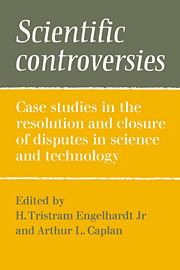 Scientific Controversies
Scientific Controversies Book contents
- Frontmatter
- Contents
- Preface
- List of contributors
- Introduction: Patterns of controversy and closure: the interplay of knowledge, values, and political forces
- PART I THEORETICAL PERSPECTIVES
- PART II CONTEMPORARY CASE STUDIES
- 12 Resolution of the Laetrile controversy: past attempts and future prospects
- 13 Federal regulation of Laetrile
- 14 Quasi libertarianism and the Laetrile controversy
- 15 Judicial deflection of scientific questions: pushing the Laetrile controversy toward medical closure
- 16 Politics, science, and the problem of psychiatric nomenclature: a case study of the American Psychiatric Association referendum on homosexuality
- 17 The diagnostic status of homosexuality in DSM-III: a reformulation of the issues
- 18 On arriving at the American Psychiatric Association decision on homosexuality
- 19 Values in the debate over workplace safety and health: the rancorous rhetoric about regulation
- 20 The successful experiment that failed
- 21 The power of efficiency: balancing benefits and costs in regulating occupational exposure to toxic substances
- 22 Closure in occupational safety and health: the benzene and cotton dust decisions
- 23 Nuclear fear: a history and an experiment
- 24 Closure and controversy: Three Mile Island
- 25 Understanding the nuclear power controversy
- PART III CONTROVERSY, CLOSURE, AND THE PUBLIC
- Author index
- Subject index
20 - The successful experiment that failed
Published online by Cambridge University Press: 03 February 2010
- Frontmatter
- Contents
- Preface
- List of contributors
- Introduction: Patterns of controversy and closure: the interplay of knowledge, values, and political forces
- PART I THEORETICAL PERSPECTIVES
- PART II CONTEMPORARY CASE STUDIES
- 12 Resolution of the Laetrile controversy: past attempts and future prospects
- 13 Federal regulation of Laetrile
- 14 Quasi libertarianism and the Laetrile controversy
- 15 Judicial deflection of scientific questions: pushing the Laetrile controversy toward medical closure
- 16 Politics, science, and the problem of psychiatric nomenclature: a case study of the American Psychiatric Association referendum on homosexuality
- 17 The diagnostic status of homosexuality in DSM-III: a reformulation of the issues
- 18 On arriving at the American Psychiatric Association decision on homosexuality
- 19 Values in the debate over workplace safety and health: the rancorous rhetoric about regulation
- 20 The successful experiment that failed
- 21 The power of efficiency: balancing benefits and costs in regulating occupational exposure to toxic substances
- 22 Closure in occupational safety and health: the benzene and cotton dust decisions
- 23 Nuclear fear: a history and an experiment
- 24 Closure and controversy: Three Mile Island
- 25 Understanding the nuclear power controversy
- PART III CONTROVERSY, CLOSURE, AND THE PUBLIC
- Author index
- Subject index
Summary
Epidemiological studies are of limited value in detecting agents that can induce neoplasms. There are, however, a series of procedures that can be performed in high-risk populations that have the potential to identify carcinogenic and mutagenic chemicals in our environment. Here I will discuss the incidence of cancer in the workplace; the limitations of classical epidemiological studies; available relevant short-term procedures for detecting carcinogens or mutagens in the workplace; the Dow Chemical Company experience with these methods; and the reasons why they are not being routinely used in industry to screen workers for exposure to carcinogenic and mutagenic agents.
Cancer and the workplace
The prevention of cancer and genetic diseases, as opposed to their treatment, is based on three premises: (1) Cancer and genetic diseases are caused, in part, by exogenous factors such as chemicals in the workplace; (2) such factors can be identified; and (3) once identified, these factors can be eliminated, or measures can be taken to minimize exposure.
At the present time the debate is particularly active about how much our life-style causes or contributes to our overall cancer burden – that is, how much our personal habits (including nutrition, smoking, and alcohol consumption), as opposed to factors not under our personal control (such as air pollution, food additives, and the occupational environment), contribute to the development of cancer.
Cancer is a disease caused by many factors and such factors as smoking and occupational hazards can act in an additive or synergistic fashion with other elements in the genesis of a specific neoplasm.
- Type
- Chapter
- Information
- Scientific ControversiesCase Studies in the Resolution and Closure of Disputes in Science and Technology, pp. 465 - 486Publisher: Cambridge University PressPrint publication year: 1987
